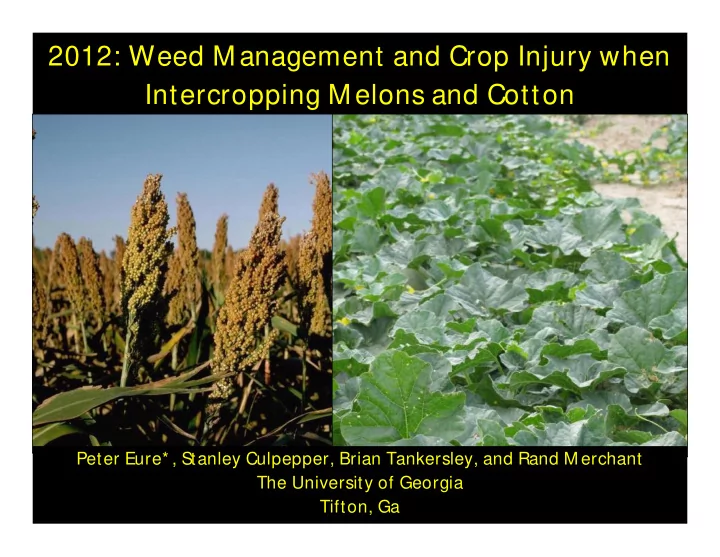

2012: Weed M anagement and Crop Injury when Intercropping Melons and Cotton Peter Eure* , Stanley Culpepper, Brian Tankersley, and Rand M erchant The University of Georgia Tifton, Ga
Introduction • Cantaloupe or watermelon intercropped with cotton – Increase resource efficiency – Improve grower profit – Stability in production
Cantaloupe and Cotton Intercropped (Tift County, GA)
Objectives 1. Identify herbicide systems to manage troublesome weeds in melon-cotton intercropping production 2. Determine the profitability of melon-cotton intercropping versus a monoculture of melon or cotton
Hypothesis 1. Herbicide options exist to adequately control weeds in melon-cotton intercropping systems 2. Crop value per acre will be greater when melon and cotton are intercropped versus a monoculture of melon or cotton
M aterials and M ethods • Two separate field studies conducted at Ty Ty, Georgia on a Tifton loamy sand during 2011 – Cantaloupe – Watermelon • Each study consisted of: – Two planting dates of melon-cotton intercrops, three herbicide systems and a non-treated control – M elon and cotton alone were planted for each planting date to serve as comparisons
M aterials and M ethods M elons were transplanted • into a 0.8 mil plastic mulch having an 18” wide bed top Cotton plantings for each • planting date were made when the initial melon vine reached the mulch edge PHY 499 WRF was planted on • 36 inch row spacing, using a 2-row planter centered over the plastic mulch
Cotton Intercropping systems were managed for melon production until harvest
M aterial and M ethods • Data recorded throughout the season: – Visual estimates of Palmer amaranth control – M elon and cotton injury – M elon vine length – Cotton height – M elon and cotton yield • M elon harvested by hand • Cotton harvested using a spindle picker designed for small plot research
M aterial and M ethods • Total crop value per acre of intercropping systems and monoculture systems were calculated – Total crop value/ A=value of total products generated-cost to produce crop • Data subjected to ANOVA and means separated using Fisher’s Protected LSD (p ≤ 0.05) when appropriate
Cantaloupe-cotton intercropping “ Athena” cantaloupe transplanted: • Transplant date 1: April 5, 2011 • Transplant date 2: April 20, 2011 Herbicide treatments in intercropping systems: 1.Ethalfluralin (0.75 lbs ai/ A) preplant 2.Ethalfluralin + Fomesafen (0.25 lb ai/ A) preplant 3.Ethalfluralin + Fomesafen preplant fb Halosulfuron (0.032 lb ai/ A) + NIS (0.25% v/ v) 10 days after transplant 4.Non-treated control Herbicide treatments in monoculture systems: M elon: Ethalfluralin + Fomesafen preplant – Cotton: Sequential applications of Glufosinate + S - – metolachlor or Glyphosate + Acetochlor when sensitive weeds were less than three inches tall
Palmer amaranth control prior to cantaloupe harvest Ethalfluralin Ethalfluralin + Ethalfluralin + Fomesafen Fomesafen fb Halosulfuron LSD(P ≤ 0.05)=2
Non-treated control Ethalfluralin + Fomesafen fb * Average of 57 Palmer amaranth in NTC Halosulfuron * * Picture taken 8 weeks after transplant
Cantaloupe Yield NTC Ethalfluralin Ethalfluralin + Ethalfluralin + Ethalfluralin + Fomesafen Fomesafen fb Fomesafen Halosulfuron (Cantaloupe Only) LSD(P ≤ 0.05)=558 * Data pooled over planting and harvest dates
Palmer amaranth control prior to cotton harvest LSD(P ≤ 0.05)=5 * Data pooled over planting dates
Lint Cotton Yield NTC Ethalfluralin Ethalfluralin + Ethalfluralin + Cotton Only Fomesafen Fomesafen fb Halosulfuron LSD(P ≤ 0.05)=119
Cantaloupe-cotton intercropping vs. monoculture * Data pooled over planting dates * * Calculated using $530 and $2,450 as the cost to produce and harvest cotton and cantaloupe, respectively. Cotton value set at $0.92/ lb. and cantaloupe value set at $1.00/ fruit.
Watermelon-cotton intercropping “ M elody” (seedless) watermelon transplanted: • For pollination, “ Sangria” transplanted every fourth plant Transplant date 1: M arch 23, 2011 • Transplant date 2: April 7, 2011 • Herbicide treatments in intercropping systems 1.Ethalfluralin (0.75 lbs ai/ A) preplant 2.Ethalfluralin + Fomesafen (0.25 lb ai/ A) preplant 3.Ethalfluralin + Fomesafen + Terbacil (0.2 lb ai/ A) preplant 4.Non-treated control Herbicide treatments in monoculture systems: M elon: Ethalfluralin + Fomesafen preplant Cotton: Sequential applications of Glufosinate + S - metolachlor or Glyphosate + Acetochlor when sensitive weeds were less than three inches tall
Palmer amaranth control prior to watermelon harvest Ethalfluralin Ethalfluralin + Ethalfluralin + Fomesafen Fomesafen + Terbacil
Non-treated control Ethalfluralin + Fomesafen * Average of 160 Palmer amaranth in NTC * * Picture taken 8 weeks after transplant
Terbacil Injury
Watermelon Yield NTC Ethalfluralin Ethalfluralin + Ethalfluralin + Ethalfluralin + Fomesafen Fomesafen + Fomesafen Terbacil (Watermelon Only) LSD(P ≤ 0.05)= 6696 * Data pooled over planting and harvest dates
Palmer amaranth control prior to cotton harvest LSD(P ≤ 0.05)= 7 * Data pooled over planting dates
Lint Cotton Yield NTC Ethalfluralin Ethalfluralin + Ethalfluralin + Cotton Only Fomesafen Fomesafen + Terbacil LSD(P ≤ 0.05)= 41
Watermelon-cotton intercropping vs. monoculture * Data pooled over planting dates * * Calculated using $530 and $2900 as the cost to produce and harvest cotton and watermelon, respectively. Cotton value set at $0.92/ lb. and watermelon value set at $0.15/ lb.
Conclusions • M elon-cotton intercropping improved total crop value per acre as compared to a monoculture of melons or cotton • Herbicide options exist for adequate control of troublesome weeds in melon-cotton intercropping systems – Fomesafen is not registered for use in watermelon or cantaloupe – Halosulfuron and ethalfluralin are not registered for use in cotton
Future Research • Registration of fomesafen for use in watermelon and cantaloupe • Registration of preplant applications of halosulfuron and ethalfluralin for cotton • Complete a comprehensive economic budget comparison of these systems
Questions or Comments?
Introduction • Background on spring melon production – Transplant late M arch to late April – Harvest mid to late June – M elons followed by plant grain sorghum Smith and Smith, 2011
Recommend
More recommend